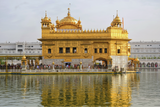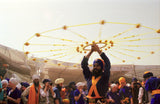This Punjabi Businessman Transformed The Lives of Millions of Indians in America
Jagjit Singh, a prominent businessman and lobbyist, may be seen standing to the left of US President Harry Truman as he signs the Luce-Celler Act of 1946. J J Singh, an Indian businessman in New York, was not only a passionate champion of India's liberation fight but also played a vital role in molding American politics and assisting millions of Indians in obtaining US citizenship.
The passing of this act conferred citizenship privileges to the 4,000-odd Indians already living in the United States and established a quota of 100 Indians and 100 Filipinos every year.
It was the climax of a successful campaign by Indians living in America to reverse the US Supreme Court's verdict in the 1923 United States vs. Bhagat Singh Thind case, which essentially denied them naturalized citizenship, as well as the 1924 Immigration Act, approved by Congress, which barred Asian immigration. President Truman gave Jagjit Singh, also known as JJ Singh, the pen he used to sign the Luce-Celler Act into law during the event.
Sabrina Singh, his granddaughter, now wields that pen. Before departing to work for the US Department of Defense last month, Singh was the deputy press secretary for US Vice-President Kamala Harris.

Sabrina Singh (Photo courtesy: Opinion Express)
The Luce-Celler Act cleared the way for the Immigration and Nationality Act of 1965, a more broad-based piece of legislation that removed restrictions on the number of people from any particular country who might come to the United States. In other words, this 1965 bill completely abolished the quota system, allowing immigrant families to reunite, and made it easier for talented workers to enter the US. Once it became a law, it allowed Indians who wanted to live better lives in the US to do so in droves.
JJ Singh, The Pioneer Who Started The Indian American Movement, is Profiled in This Extraordinary Tale.

Photo courtesy: Times of India
Experiencing the battle for freedom and building riches abroad
Singh was born on October 5, 1897, in Rawalpindi, and grew up in relative affluence because his father was a court official. He traveled with his father as a youngster around Punjab's former British Indian region.
Everything changed for young Singh after the Jallianwala Bagh tragedy in Amritsar on April 13, 1919. He joined the MK Gandhi-led mass non-cooperation movement. Singh, however, became disillusioned and left India to pursue a legal education in the UK after Gandhi unexpectedly called off the event in 1922 due to unrest in Chauri Chaura.
However, he became interested in apparel wear abroad. He quickly began importing silk textiles, handlooms, and other such things from India to sell them overseas with his cousin's help. He came to the US in 1926 to exhibit his goods at the Philadelphia Sesquicentennial Exhibition. Later, he would establish shops in Philadelphia and on Fifth Avenue in New York.
The stylish crowd was wearing his dresses and gowns in New York, where business was thriving. He could infiltrate some of the city's most elite circles because of his success in the Indian garment and textile industry.
In other words, JJ evolved into the ideal example of a successful immigrant. He founded the Indian Chamber of Commerce in the US in the middle of the 1930s to improve economic ties between his nation of business and British India. However, he saw that commerce and India's capacity to realize her economic potential were being hampered by limitations imposed by colonial control. Additionally, he was monitoring Indian developments because of the nature of his firm.
J.J Singh as The India League of America

Photo courtesy: SAADA.org
He took over as head of the India League in December 1941. The British not only imprisoned India's prominent freedom activists but also conducted a propaganda blitz in the United States in the summer of 1942 to persuade Americans that independence for India would interfere and ultimately destroy the war effort. This was the same month the Japanese attacked Pearl Harbour, and the United States formally entered World War II.
Given his ambition to see a liberated India, Singh was not having any of that. He made a handful of wise decisions while serving as president of the India League. First, he allowed influential Americans from various ethnic backgrounds and political viewpoints to join, including Detroit labor leaders, African Americans like Walter White of the National Association for the Advancement of Colored People (NAACP), ordained ministers, socialists, Chinese immigrants, and even some lawmakers. In reality, Sidney Hertzberg, a publicist, activist, writer, editor, and Unitarian clergyman John Haynes Holmes were among Singh's closest confidantes at the time.
Second, he established an office for the India League in Washington, DC, from which he often lobbied members of the US Congress and spoke to important media outlets. He frequently discussed topics like the Bengal famine, the atrocities of British colonial authority in India, and Japanese military development in South Asia while speaking with politicians and the media.
During a radio interview in 1942, Singh stated, “Indians believe in the teachings of Lincoln and Washington. Indians want to be given the chance to fight and to die for freedom and democracy.”
His services helped the Indian League become one of the de facto voices for roughly 4,000 Indians in the US. The Indian League not only became more outspoken but also increased in size. By publishing pamphlets and bulletins, and planning events for key decision-makers in Washington, they promoted two primary causes: securing citizenship rights for India in the US and pushing Americans to support India's fight for independence.
The British retaliated, of course. Their operatives infiltrated the India League and attempted to get JJ Singh into problems with federal law enforcement. Singh retaliated by having India League allies penetrate the British Embassy and disseminate damaging documents. On Capitol Hill, his persistent lobbying efforts were starting to pay off. He persuaded Congressmen to support India's cause and give citizenship to Indian immigrants.
The situation reached a breaking point in 1944 when a columnist for the Washington Post revealed that William Phillips, the envoy of US president Franklin D. Roosevelt in India, had secretly lobbied the White House to assist India's demand for independence. He claimed that promising India freedom would significantly aid the fight against the Japanese.
Drew Pearson, a Washington Post columnist, obtained this material through a leak arranged by the India League's associates. Of course, Singh used this knowledge to increase American support for the independence of India.
Singh was also working through the night to reverse the 1923 ruling by the US Supreme Court that barred Indians from obtaining naturalization. He collaborated on a measure to overturn the court's decision and the ensuing 1924 Immigration Act with two US Congressmen, Clare Boothe Luce, and Emanuel Celler. He also recruited other powerful personalities to endorse the legislation that would eventually become the Luce-Celler Act, including the eminent physicist Albert Einstein and the African American civil rights campaigner W. E. B. Du Bois.
Even further, he would contact "every newspaper and magazine in the United States" to urge support for the legislation they had written.
After all of that, it's critical to remember that in addition to JJ Singh and the India League, influential Indians and groups like Tarakanath Das' Free Hindustan, Friends of Freedom for India, the India Association for American Citizenship, Mubarek Ali Khan's India Welfare League, and Anup Singh's National Committee for India's Freedom worked for causes close to his heart. However, Singh's contribution to the cause of Indians and India was crucial in many ways.
Members of the United States Congress also agreed to this bill for political reasons. After all, the United States needed to protect its Asian allies from the Japanese. That is why the quota system included Indians and Filipinos.

Courtesy: JJ Singh's family collection
We can all still witness the legacy he leaves behind today.
Ultimately, Singh chose not to become a citizen of the US. With his wife, Malti Saksena, and their two small kids, he returned to India in 1959. In 1976, he passed away in India.



